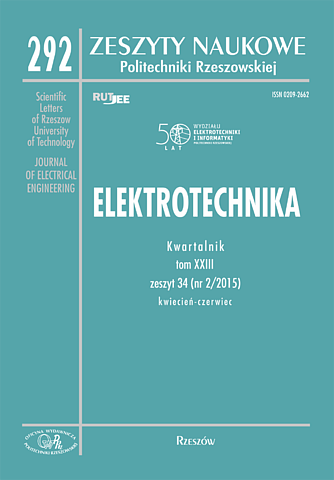Abstract
The continual development of the electronics industry and elaborations of newer and newer applications make potential of printed electronics, which complements other technologies, continuously growing. Flexibility is becoming a very desirable feature which is of particular importance in many areas. For this reason technologies which were known so far in other spheres of socialeconomic activities are starting to play the substantial role; however, due to the little developed material base, they were not noticed in the electronics field. Ink jet printing presents so far in the printing industry, but it is increasing its participation in the electronics industry. The manufacturing of printed circuit boards and various other structures using this technique is currently the subject of many researches. For this reason in the presented article, the basic material base in chosen electronic applications was characterized and flexible printed electronics manufacturing processes using the mentioned technology was described. Both technological process and materials were included in the context of researches conducted in the HYBRID laboratory at Department of Electronic and Communications Systems. The technological process for the realization of RFID identifiers antenna structures using PixDro LP50 inkjet printing system was discussed as well as there were mentioned problems which are appearing in this respect. The approach presented in this article has a cognitive character and constitutes the base for further research works.
References
[2] Nie X., Wang H., Zou J.: „Inkjet printing of silver citrate conductive ink on PET substrate”, Applied Surface Science, vol. 261, 2012, pp. 554-560
[3] Kamyshny A., Steinke J., Magdassi S.: „Metal-based Inkjet Inks for Printed Electronics”, The Open Applied Physics Journal, vol. 4, 2011, pp. 19-36
[4] Li Y., Rida A., Vyas R., Tentzeris, M.M.: „RFID Tag and RF Structures on a Paper Substrate Using Inkjet-Printing Technology”, IEEE Transactions on Microwave Theory and Techniques, vol. 55 (12), 2007, pp. 2894-2901
[5] Janeczek K., Jankowski-Mihułowicz P., Jakubowska M., Kozioł G., Młożniak A., Futera K., Stęplewski W.: „Performance Characterization of UHF RFID Antennas Manufactured with Screen Printing Technique on Flexible Substrates”, Microelectronic Materials and Technologies, vol. 2, 2012, pp. 61-74
[6] Węglarski M., Jankowski-Mihułowicz P., Tomaszewski G., Flexible antenna design for HF RFID semi-passive transponder in inkjet technology, XI Symposium of Magnetic Measurements SPM, Częstochowa-Woźniki, 21.10.2014
[7] Zardetto V., Brown T.M., Reale A., Di Carlo A.: „Substrates for flexible electronics: A practical investigation on the electrical, film flexibility, optical, temperature, and solvent resistance properties”, Journal of Polymer Science Part B: Polymer Physics, vol. 49 (9), 2011, pp. 638-648
[8] DuPont™ Kapton® HN polyimide film - Technical Data Sheet, 2011
[9] DuPont™ Mylar® polyester film - Product Information, 2003
[10] Teijin DuPont Films - Teonex Product Information, 2004
[11] Felba J., Mościcki A.: „Wykorzystanie druku strumieniowego do tworzenia mikrostrukturprzewodzących elektrycznie”, Drukowana elektronika w Polsce (Jakubowska M., Sitek J., red.), Monografia Instytutu Tele- i Radiotechnicznego, 2010
[12] Harima Chemicals Group: „NanoPaste series – Concept & Electronic Materials”, nota katalogowa pobrana ze strony producenta, 2013, pp. 21
[13] Amepox Microelectronics: „Nano Ink AX JP-6n Atrament przewodzący do drukowania Ink Jet”, nota katalogowa pobrana ze strony producenta, 2013
[14] Amepox Microelectronics: „Nano Ink AX JP-60n Low Temperature Conductive Ink for Jet Printing”, nota katalogowa pobrana ze strony producenta, 2014
[15] Yin Z., Huang Y., Bu N., Wang X., Xiong Y.: „Inkjet printing for flexible electronics: Materials, processes and equipments”, Chin. Sci. Bull., vol. 55 (30), 2010, pp. 3383-3407
[16] Tomaszewski G., Potencki J., Wałach T., Pilecki M.: „Investigation of ink spreading on various substrates in inkjet technology”, Proceedings of 38th International IMAPS-CPMT Poland Conference & Exhibition, 2014
[17] Lee D.J., Oh J.H., Bae H.S.: „Crack formation and substrate effects on electrical resistivity of inkjet-printed Ag lines”, Materials Letters, vol. 64 (9), 2010, pp. 1069- 1072
[18] Shi C.W.P., Shan Xuechuan, Tarapata G., Jachowicz R., Weremczuk J., Hui T.H.: „Fabrication of Wireless Sensors on Flexible Film Using Sreen Printing and via Filling", Microsystem Technologies, Springer, vol. 17, 2011, pp. 661-667
[19] Dziedzic A., Słobodzian P.: „Modern Microelectronic Technologies in Fabrication of RFID Tags", Radioengineering, vol.20, 2011, pp.187-193
[20] Soo-Jin Park, Eun-Jung Lee, Kwon Soo-Han: „Influence of Surface Treatment of Polyimide Film on Adhesion Enhancement between Polyimide and Metal Films”, Bulletin of the Korean Chemical Society, vol. 28, 2007, pp. 188-192





